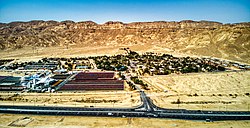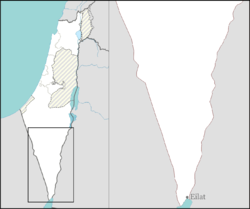Ketura, Israel
Ketura
קְטוּרָה كيتورا | |
|---|---|
 | |
| Coordinates:29°58′13″N35°3′41″E/ 29.97028°N 35.06139°E | |
| Country | Israel |
| District | Southern |
| Council | Hevel Eilot |
| Affiliation | Kibbutz Movement |
| Founded | November 1973 |
| Founded by | AmericanYoung JudaeaMembers |
| Population (2022)[1] | 509 |
| Website | www.ketura.org.il |
Ketura(Hebrew:קְטוּרָה) is akibbutzin southernIsrael.Located north ofEilatin theAravahValley, it falls under the jurisdiction ofHevel Eilot Regional Council.In 2022 it had a population of 509.[1]
Name
[edit]The name Ketura was taken from a nearby hill and wadi, and is also the name ofthe second wifeofAbraham(Genesis 25:1).
History
[edit]Ketura was founded in November 1973 by a group of youngAmerican Jewishimmigrants, most of them members of the Zionist youth movementYoung Judaea.[2]Difficulties in the early years frustrated many of the inhabitants of the kibbutz, which caused many of the founders to leave. At the same time, more Young Judaeans joined the community, along with a variety of other immigrants as well asIsrael Boy and Girl Scouts Federationgraduates. Ketura is in the Southern Arava - Hevel Eilot Regional Council.
Today Ketura has about 165 members and several young families who are candidates to become members. During the year there are about 500 people living on Ketura, members and their families, students in theArava Institute for Environmental Studies,volunteers from around the world,Arava International Center for Agriculture Training(AICAT) students from around the world,NOAM youth movementmembers in various programs such asgap yearorservice year (shnat sherut),Israeli post-army 'avoda muedefet' participants, and researchers who come to work in regional institutes.
Religious culture
[edit]Ketura is unique among kibbutzim for its religious pluralism. Although the kibbutz is not considered a religious kibbutz,Jewish dietary laws(kashrut) andSabbath rulesare observed in the dining room, public areas, and at social and cultural events, and there is a functioning congregation-led egalitarian synagogue. The population of the kibbutz is composed of observant,masorati(moderately observant), and secular members, an unusual situation for a kibbutz. Ketura received the Speaker of theKnessetPrize for religious tolerance as a result of its religious progressiveness.
Economy
[edit]
The kibbutz is best known for its involvement in ecological activities, mainly its partnership in the local algae factory, Algatech,[3]and its guest house and educational seminar center, Keren Kolot.[4]Thesolar powerindustry (seebelow) has been gaining importance locally.
Economic cooperation with other kibbutzim in the area includes a regional date-packing plant, Ardom Computing Services, and Ardag, a large fish hatchery near Eilat. Many members work outside the kibbutz in professional positions such as teachers, physical and occupational therapists, researchers, social workers, and more. Ketura also offers accounting and bookkeeping services, with many members working in these positions. A number of members work in the local NGO—TheArava Institute for Environmental Studies(AIES).

Agriculture
[edit]Agricultural enterprises of the kibbutz include date orchards.[5]
Guest house and seminar center
[edit]The kibbutz is well known for its guest house and educational seminar center — Keren Kolot[4]
Algae production and processing
[edit]The red rainwatermicroalgae(Haematococcus pluvialis) aresingle-cell organisms,part of the oldest group of living organisms.[6]Their long evolution led them to adapt to extreme conditions and to develop survival mechanisms againstbacteriaandfungi.[6]Haematococcus pluvialis has been cultivated and processed at Ketura since 1998, when theAlgaTechnologies, Ltd.company was established, for their content ofastaxanthin,one of the strongest known naturalantioxidantsubstances, considered to benefic to theimmune,cardiovascularandnervous systems,to joints and muscles.[7][6]The main Algatech product, AstaPure, is natural astaxanthin extracted from the algae.[6]It is mainly sold the United States, Japan and Europe—in total, to more than 30 countries,[6]where it is used as a natural ingredient and pigment for use in cosmetics;[3]and as anutraceutical,including as an ingredient for dietary supplements.[6]Research has proven astaxanthin to have positive health effects on a multitude of organs and body functions, such as: eyesight, skin, physical effort during sport activities, cognitive abilities, anti-inflammatory effects and so forth.[6]Algatech, to which Kibbutz Ketura is a partner, is considered a leading company in microalgae agriculture and one of the most forward-looking innovators in the field, worldwide.[6]
Environmentalism
[edit]
Ketura is part of the Green Kibbutz movement. In addition to promoting awareness, recycling and opening asecond-hand store,Ketura planted acommunity gardenand operates a high-tech algae farm.[2]
Arava Institute for Environmental Studies
[edit]Members of Ketura founded the Arava Institute for Environmental Studies (AIES), which is located at Ketura. The institute promotes regional environmental cooperation between Israelis, Palestinians and residents of neighbouring Arab countries in environmental matters, with a focus ondesert ecosystems.[8][2]
Solar power
[edit]Ketura is a partner in the Arava Power Company (APC),[9]producing electricity fromsolar panels.There is one 4.95MW field on the kibbutz,Ketura Sun,with a second 40MW field opened in 2015, then the largest in Israel.[10]
Date palm grown from germinated ancient seed
[edit]The first surviving example of theJudean date palm,artificially germinated from a 2,000-year-old seed discovered during archaeological excavations inMasada,was planted in Ketura and continues to survive there. It was nicknamed 'Methuselah'. Several others have since been grown from seeds found in theDead Searegion, including some female specimens, which are likely to one day be pollinated by material from Methuselah.
Notable people
[edit]See also
[edit]- Agricultural research in Israel
- Grovepoint Capital
- Social entrepreneurship
- Solar power in Israel
- Ecovillages
References
[edit]- ^ab"Regional Statistics".Israel Central Bureau of Statistics.Retrieved21 March2024.
- ^abcKershner, Isabel (April 20, 2012)."Israeli Desert Yields a Harvest of Energy".The New York Times.RetrievedApril 24,2019.
- ^abAlgatech homepage
- ^abKeren Kolot homepage
- ^Kibbutz Ketura homepage
- ^abcdefghKamar, Assaf (March 22, 2018)."Turning the desert green and red".YNet News.RetrievedApril 24,2019.
- ^Leichman, Abigail Klein (March 17, 2003)."The powerful new antioxidant made of sun and algae".Israel 21c.RetrievedApril 24,2019.
- ^Arava Institute for Environmental Studies homepage
- ^Arava Power Company homepage
- ^Sharon Udasin,Israel's largest solar field begins flowing to the national grid,The Jerusalem Post, 29 July 2015. Accessed 24 September 2018.


